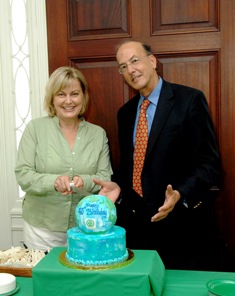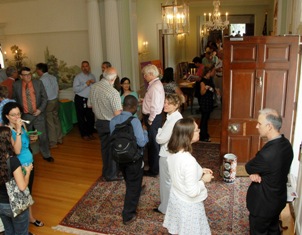Fogarty turns forty, faces new challenges
July / August, 2008 | Volume 7, Issue 4

Foundation for the NIH Executive
Director Amy Porter and Fogarty
Director Dr. Roger Glass helped to
celebrate the 40th anniversary of
the Fogarty International Center.
In his 20 years as chairman of the House subcommittee that funded what is now HHS, Rep. John E. Fogarty (D-R.I.) had a vision to create a more peaceful world by sharing biomedical research discoveries with other nations. But he died at his desk before the dream of a "Health for Peace" institute could be realized.
His legacy turned out to be the Fogarty International Center, which celebrated its 40th anniversary in July with an open house for NIH staff at the historical Stone House.
Back in Fogarty's heyday, Congress was much less partisan than today, and he won the admiration and cooperation of many Republicans concerned with health issues.
The power of appropriators was so great and Fogarty's likeability so wide that he single-handedly raised the NIH budget from $37 million to $1.24 billion during his chairmanship.
That he was such an ardent health research advocate might not be expected from his background. Born in Providence, R.I., March 23, 1913, Fogarty finished high school and, like his father, became a bricklayer. Within 10 years he was president of the statewide union.
Elected to Congress in 1940 at the age of 27, he won appointment seven years later to the House Appropriations Committee and its subcommittee that controlled spending for the NIH and other agencies in the old Department of Health, Education and Welfare.
Two years later he became the subcommittee's youngest chairman and devoted himself to the task of dismantling the brick wall of congressional resistance to spending on health research.

Photo courtesy of the
Fogarty family
Congressman John E. Fogarty
died while preparing legislation
to fund global health research.
Unusual for that day, he would badger friendly witnesses from the NIH at budget time about why they were not asking for more money. The answer was that they were dutifully defending the request of the president, their ultimate boss.
The result? A lot of money. Usually a lot more than the president had requested.
In addition to promoting research throughout his congressional career, Fogarty consistently urged funding for the disabled and those with mental and physical impairments, as well as for medical libraries.
By 1963, he was dreaming of "a great international center for research...dedicated to international cooperation."
"I should like to see...at Bethesda a great international center for research in biology and medicine dedicated to international cooperation and collaboration in the interests of the health of mankind..."
Rep. John Edward Fogarty, 1963
He died Jan. 10, 1967, while preparing to re-introduce such legislation, and 18 months later President Johnson created the John E. Fogarty International Center in his memory.
From a starting budget of $500,000 that has grown to $67 million, the Fogarty Center today supports more than 5,000 researchers in more than 100 countries.
After his death, the New York Times editorialized: "No one in the history of this country has done more to promote more and better health services, more and better health facilities and more and better health research than Representative Fogarty.
Biomedical research has always been an inherently international enterprise, says Fogarty International Center Director Dr. Roger I. Glass.
"In this era of globalization, the trend will not only continue, but will likely become stronger," he says.
"It will also require a well-trained cadre of U.S. health scientists who are able to work seamlessly in diverse settings. If we are to continue to lead in biomedical research, then U.S. researchers must be encouraged to effectively participate in international science."

NIH staff attended an open house to celebrate the
40th anniversary of the Fogarty International Center.
Some Fogarty initiatives already are making inroads.
For example, to ensure the sustainability of programs such as the President's Emergency Plan for AIDS Relief (PEPFAR) and the Global Fund to Fight HIV/AIDS, TB and Malaria, countries will need scientists with the research skills necessary to overcome implementation barriers as prevention, care and treatment programs are developed. To help satisfy that need, Fogarty's International Clinical, Operational, Health Services Training Awards for AIDS and TB have begun strengthening the skills of scientists in low- and middle-income countries to do research on implementing promising interventions at population and health care system levels.
Rep. John E. Fogarty, for whom the Center was named, was prescient in arguing the needs and rewards of global health research 50 years ago. Today, the Center is extending his vision in a world made smaller and more interdependent by international trade, travel and the Internet.
The Center has set an ambitious course for the future, addressing emerging areas of science and shifting disease burdens, and helping to build the global health research workforce in the United States and around the world.
"We envision a world in which numerous centers of research excellence in the developing world will support a skilled scientific workforce that understands how to improve health outcomes and systems through rigorous research," says Glass. These centers will be linked with one another through emerging information and communications technologies.
"Working toward this vision moves us closer to the ideal of global health, one that reflects the aspiration of every human being on the planet to live a long and healthy life."
More Information
To view Adobe PDF files,
download current, free accessible plug-ins from Adobe's website.